Papers by Grzegorz Michalec
Antiquity, 2024
Large-scale field research is providing extensive data on the prehistoric settlement history of t... more Large-scale field research is providing extensive data on the prehistoric settlement history of the Bayuda Desert in Sudan. The authors briefly examine notable outputs from the project, including some of the more than 100 radiocarbon dates that permit a more nuanced understanding of the chronology of settlement pattern changes.
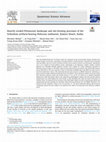
Quaternary Science Advances, 2024
Since the Middle Pleistocene, the Sahara region has undergone strong environmental changes result... more Since the Middle Pleistocene, the Sahara region has undergone strong environmental changes resulting from climate changes. Dry periods, constituting an ecological barrier to human presence, alternated with wet periods when the Sahara area was covered with green savanna and an extensive network of watercourses, allowing the area to be occupied by hunter-gatherer groups. Responding to the Quaternary climatic changes, hominin dispersal was channeled through vegetated corridors. Such evidence for human settlements connected to Pleistocene green corridors in the Sahara region has been discovered in the research area called EDAR (Eastern Desert Atbara River). This area comprises a cluster of Acheulean and Middle Stone Age (MSA) sites discovered in the fluvial sedimentary context. This manuscript discusses the occurrence of Middle Pleistocene Acheulean artifacts in much younger sediments documented at the site EDAR 6. These Acheulean artifacts are present within thick Holocene calcareous sandy silts formed between 2.7 ka and 8.7 ka based on an optically stimulated luminescence (OSL) chronology, which is also supported by paleomagnetic analysis. The stone gravelly artifacts
mantled above the eolian deposits have been known in other Paleolithic sites under the desert environment of Northern Africa. We propose that the relocation of the Palaeolithic artifacts was due to long-lasting erosional and redepositional processes affecting the Acheulean artifacts-bearing sediments since the Middle Pleistocene. We interpret that the cumulative results of the two processes, i.e., the gravel framework dilation and the gravel overpassing, allowed the stone artifacts to be exposed at the surface or incorporated in the Holocene sediment layers.

Journal of Field Archaeology, 2024
This article presents the results of research carried out at two previously unreported Eastern De... more This article presents the results of research carried out at two previously unreported Eastern Desert Atbara River project (EDAR) Middle Stone Age (MSA) sites-EDAR 134 and EDAR 155. Luminescence dating results indicate human activity in this area during the Marine Isotope Stage 5 period (MIS 5), approximately 90 kya. Discussion concerning the affiliation of both analyzed inventories will be provided, including another MSA site from the EDAR area, where an assemblage dated to MIS 6/5e does not have technological features known from other technocomplexes in the eastern Sahara region (EDAR 135). Microscopic analysis of traces of tool use for the EDAR 155 assemblage shows the high impact of post-depositional (aeolian) processes on the state of preservation of lithic material. Sites EDAR 134 and 155 provide evidence for hominin activity during the late Pleistocene within an area only episodically accessible, due to arid conditions prevailing in the Saharan deserts.
Antiquity, 2024
The authors present results from a new research project focusing on the prehistory of the area su... more The authors present results from a new research project focusing on the prehistory of the area surrounding a vast flint outcrop in Mongolia, called Tsakhiurtyn Hundi, in the borderland between the Gobi-Altai Mountains and Gobi Desert. They present the discovery of a cave and the results of its exploration, confirming its use by Pleistocene hunter-gatherers.
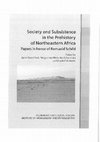
Society and Subsistence in the Prehistory of Northeastern Africa:Papers in honor of Romuald SchildEdition: Studies in African Archaeology 17, edited by Jacek Kabaciński, Małgorzata Winiarska-Kabacińska and Marek ChłodnickiChapter: III. Oases and the DesertPublisher: Poznań Archaeological Museum p..., 2023
This article is dedicated to yet another site belonging to the agglomerationof Pleistocene sites ... more This article is dedicated to yet another site belonging to the agglomerationof Pleistocene sites in the Eastern Desert in Sudan known in the literature asEDAR (Eastern Desert Atbara River)1. The discussed site – EDAR 6 – occupiesthe central position within the complex of EDAR sites; it was discovered as oneof the first Acheulean sites in the studied area. The general information aboutthe discovery and results of the research at EDAR sites have been publishedearlier (Ehlert et al. 2022; Masojć et al. 2019; 2020; 2021a; 2021b; Masojć andNassr 2019; Michalec et al. 2021; Nassr and Masojć 2018). At present publica-tions devoted to consecutive sites researched as part of the EDAR project are atvarious stages of preparation (Masojć et al. in press)
Comptes Rendus Palevol, 2023
This paper presents a case study from the Hiem cave (Hoà Bình province, North Vietnam) showing ho... more This paper presents a case study from the Hiem cave (Hoà Bình province, North Vietnam) showing how a multidisciplinary approach in archaeological research can develop knowledge on the everyday life of the hunter-gatherer Hoabinhian groups occupying the cave during the early Holocene (8500-8200 cal BC). The archaeological analysis presents the characteristic Hoabinhian artefacts and their usage, while archeozoological, malacological and archaeobotanical research throw light on the way of life, including plant and animal elements of a daily diet as well as the settlement seasonality of the cave.

AZANIA, 2022
Middle Stone Age (MSA) lithic artefacts coming from dated layers preserved in their original stra... more Middle Stone Age (MSA) lithic artefacts coming from dated layers preserved in their original stratigraphic position are still rare in Northeast Africa in general and in Sudan in particular. This paper aims to present the results of technological and functional analyses of an assemblage coming from a stratigraphic context, i.e. the upper level of the EDAR (Eastern Desert-Atbara River) 135 site, discovered in an abandoned gold mining pit in the Sudanese Eastern Desert, approximately 70 km east of the town of Atbara. The assemblage, which is based on locally available quartz and rhyolite, comes from a layer bracketed by OSL dates of 116 ± 13 and 125 ± 11 kya. Such dating places it within Marine Isotope Stage 5e-5d. Analysis of the assemblage revealed several characteristics that seem to set it apart from other MSA Northeast African inventories. Among these, the dominance of simple, nonpredetermined core reduction strategies and expedient tool types, coupled with the lack of traces of Nubian Levallois technique, are the most conspicuous. Micro-traces of use on animal and plant matter were preserved on some of the tools. EDAR 135 is part of a newly discovered complex of sites that confirms the presence of Middle and Late Pleistocene hominins along one of the possible routes out of Africa towards Eurasia.
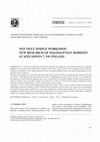
Anthropologie (Czech Republic), 2020
It is commonly accepted that the life style of hunters and gatherers of the Late Palaeolithic was... more It is commonly accepted that the life style of hunters and gatherers of the Late Palaeolithic was perfectly adapted to the environmental and climate conditions. One of the crucial aspects of the adaptation was an effective strategy of exploitation of the varied natural resources. It assumed different forms and intensity depending on interregional and local factors. The aim of this study was to answer the question which type of activity can be associated with the materials from the site Sowin 7, SW Poland, representing the late phase of Magdalenian culture, and if the site is chronologically homogeneous. Earlier research suggested that it was a remnant of a short-lived workshop of blade blank production, while our studies make it possible to adopt a more precise view. The view is based on the results of integrated technotypological studies, refitting study, as well as spatial and use-wear analysis. At present it can be said that the Magdalenian finds from Sowin 7 form a more complex spatio-functional and chronological structure. Besides the zone of blade blank production, the site held a zone where tools were prepared and repaired using organic materials. It can be also said that the northern and southern parts of the site may have originated at different times. The isolated refits, which link the two parts, indicate recycling rather than coordinated activity of one group. Similar tasks were performed during the two episodes.
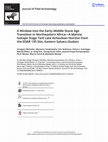
Journal of Field Archaeology, 2021
This paper presents the results of the analysis of a late Acheulean horizon from the EDAR 135 sit... more This paper presents the results of the analysis of a late Acheulean horizon from the EDAR 135 site, which was discovered in the Eastern Desert, Sudan, in an area heavily transformed by modern mining activity. A lithic assemblage was discovered there, within a layer of gravel sediments formed by a paleostream in a humid period of the Middle Pleistocene. This layer is OSL dated between 220 ± 12 and 145 ± 20 ka (MIS 7a/6). These dates indicate that the assemblage could be the youngest trace of the Acheulean in northeastern Africa. Technological analysis of the lithics reveals different core reduction strategies, including not only ad hoc ones based on multiplatform cores, but also discoidal and prepared cores. The use of prepared core reduction methods has already been confirmed at other Late Acheulean sites in Africa and the Middle East. Microwear traces observed on lithic artifacts could relate to on-site butchering activities.
Journal of African Archaeology, 2021
This research note presents evidence for the oldest Middle Pleistocene Eastern Saharan human acti... more This research note presents evidence for the oldest Middle Pleistocene Eastern Saharan human activity from the area referred to as the Eastern Desert Atbara River (EDAR), Sudan, which is currently threatened by gold mining. Preliminary results of multifaceted analyses indicate the activity of Homo sapiens during MIS 5 as well as Homo erectus during MIS 7–11 or earlier.
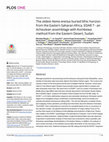
Plos One, 2021
Although essential for reconstructing hominin behaviour during the Early Palaeolithic, only a han... more Although essential for reconstructing hominin behaviour during the Early Palaeolithic, only a handful of Acheulean sites have been dated in the Eastern Sahara region. This is due to the scarcity of sites for this time period and the lack of datable material. However, recent excavations in the Atbara region (Sudan) have provided unique opportunities to analyse and date Acheulean stone tools. We report here on EDAR 7, part of a cluster of Acheulean and Middle Stone Age (MSA) sites that were recently discovered in the Eastern Desert Atbara River (EDAR) region, located in the Eastern Desert (Sudan) far from the Nile valley. At EDAR 7, a 3.5 metre sedimentary sequence was excavated, allowing an Acheulean assemblage to be investigated using a combination of sedimentology, stone tool studies and optically stimulated luminescence dating (OSL). The site has delivered a complete Acheu-lean knapping chaine opé ratoire, providing new information about the Saharan Acheulean. The EDAR 7 site is interpreted as a remnant of a campsite based on the co-occurrence of two reduction modes: one geared towards the production of Large Cutting Tools (LCTs), and the other based on the flaking of small debitage and production of flake tools. Particularly notable in the EDAR 7 assemblage is the abundance of cleavers, most of which display evidence of flake production. Implementation of giant Kombewa flakes was also observed. A geometric morphometric analysis of hand-axes was conducted to verify a possible Late Acheulean assemblage standardisation in the Nubian Sahara. In addition, the analysis of micro-traces and wear on the artefacts has provided information on the use history of the Acheulean stone tools. Sediment analyses and OSL dating show that the EDAR 7 sequence PLOS ONE

Archaeologia Polona vol. 58, 2020
This work presents Acheulean material discovered in Khor Shambat (Omdurman, Sudan), situated on t... more This work presents Acheulean material discovered in Khor Shambat (Omdurman, Sudan), situated on the left-bank Nile valley a few km north of Khor Abu Anga and about 7 km from the Nile valley, 10 km to the north-west of the confluence of the Blue and White Nile. The artefacts occur randomly in the channel or in the channel deposit, the latter forms elongated bars composed of fluvial deposits with a low degree of sorting. The assemblage consists of 34 artefacts made from highly eroded Nubian sandstones. The most common shape of the hand-axe from Khor Shambat is the cordiform type with lenticular cross section made on a chunk or cobble. The hand-axes from Khor Shambat were subject to a morphometric analysis together with the assemblage from two other Nubian Acheulean sites. The geometric-morphometric approach to 2D objects attempted to identify differences between the assemblages. The broad chronology of the Acheulean proposed for Khor Abu Anga by Roy L.Carlson might potentially be applicable to the Khor Shambat assemblage, which may fall within the range of 350–200 ka.

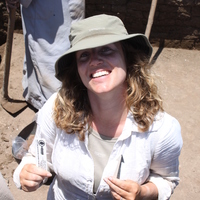
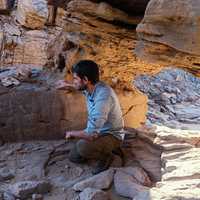
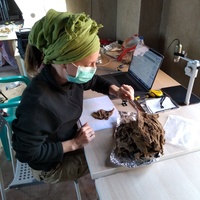



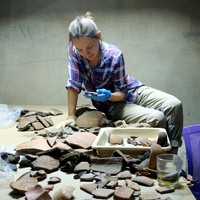



Uploads
Papers by Grzegorz Michalec
mantled above the eolian deposits have been known in other Paleolithic sites under the desert environment of Northern Africa. We propose that the relocation of the Palaeolithic artifacts was due to long-lasting erosional and redepositional processes affecting the Acheulean artifacts-bearing sediments since the Middle Pleistocene. We interpret that the cumulative results of the two processes, i.e., the gravel framework dilation and the gravel overpassing, allowed the stone artifacts to be exposed at the surface or incorporated in the Holocene sediment layers.
mantled above the eolian deposits have been known in other Paleolithic sites under the desert environment of Northern Africa. We propose that the relocation of the Palaeolithic artifacts was due to long-lasting erosional and redepositional processes affecting the Acheulean artifacts-bearing sediments since the Middle Pleistocene. We interpret that the cumulative results of the two processes, i.e., the gravel framework dilation and the gravel overpassing, allowed the stone artifacts to be exposed at the surface or incorporated in the Holocene sediment layers.